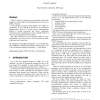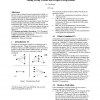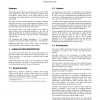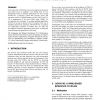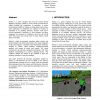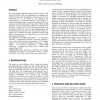VRML
1998
ACM
14 years 8 months ago
1998
ACM
VRML 2.0 allows a content creator to dynamically control state changes in a virtual reality world by defining routes of events over VRML 2.0 nodes. In the conceptual execution mod...
VRML
1998
ACM
14 years 8 months ago
1998
ACM
We have extended the VRML standard to allow free-form manipulation of objects while immersed. Our driving goal was immersed training for equipment operations and maintenance, and ...
VRML
1998
ACM
14 years 8 months ago
1998
ACM
VRML
1998
ACM
14 years 8 months ago
1998
ACM
We describe our efforts in providing REINAS (Realtime Environmental Information Network and Analysis System) weather visualization products on demand through the web. As the REINA...
VRML
1998
ACM
14 years 8 months ago
1998
ACM
This paper discusses the history and design decisions behind OpenWorlds, the first C++ toolkit for VRML 2.0 integration. OpenWorlds is a highly extensible set of libraries which s...
VRML
1998
ACM
14 years 8 months ago
1998
ACM
While many pleasing effects are possible using the current VRML sound model [9], it falls short of producing convincing aural environments. Sound sources are not easily affected b...
VRML
1998
ACM
14 years 8 months ago
1998
ACM
In its current state, VRML does not provide support for interaction and on-line access to databases, even though these are two fundamental issues for business applications. We hav...
VRML
1998
ACM
14 years 8 months ago
1998
ACM
VRML
1998
ACM
14 years 8 months ago
1998
ACM
Peloton is a sports simulator that uses the Virtual Reality Modeling Language (VRML) to create virtual environments for athletic training and competition. In particular, it create...
VRML
1998
ACM
14 years 8 months ago
1998
ACM
The Virtual Reality Modeling Language (VRML) and the World Wide Web (WWW) offer new opportunities to communicate an architect’s design intent throughout the design process. We h...
